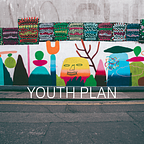Listening to the future — developing participatory sound fiction to engage youth in urban planning processes
This post is written by Johanna Männikkö and co-authored by Sofia Lundmark.
“Vårby square in 2170 is a place with a lot of people in motion and their footsteps are heard as they walk around. People speak to each other in Farsi, Hindi, Finnish, Swenglish and Swedish. […]People talk about flying kebabs being sold in the square, that the subway is coming, that the ducks are being fed with plastic and that it is hot on the square. As a result of climate change, Lake Mälaren’s water has closed in on the square and the water is therefore heard making sounds against the square’s metal floor.“
The excerpt above is part of one of the stories that were made into sound fiction by Alethe Hjuberger and Marica Myhre, as part of their bachelor thesis: “Vårby year 2170, fiction or reality?: A qualitative study of how participatory sound fiction can engage youths in urban planning processes”. The thesis, which was successfully completed in January 2022, was written in association with Planning with Youth and supervised by Martin Jonsson and Sofia Lundmark at the Media Technology Department at Södertörn University. The aim was to investigate how participatory design, design fiction, and sound design could be combined to engage youth in urban planning processes. To do this they worked with a new method called participatory sound fiction, which was tested together with youths (15–16 years old ) in a youth centre in Vårby gård, in Sweden.
Creating sounds, creating discussion
There is a need for methods that can include youth in a meaningful way in urban planning processes. Sound is a prevalent element of urban spaces, but as Alethe and Marica point out, sound is a medium that has not yet been well researched when it comes to participatory studies and urban planning processes. Therefore, the aim of participatory sound fiction is to be a method which uses sound to facilitate collaborations between city planners, designers, and youth, in planning processes.
As mentioned, participatory sound fiction combines three theoretical starting points: participatory design, design fiction and sound design. This means several factors have been important in creating the method, including enabling participants’ contributions and sense of autonomy, encouraging participants to see “the everyday” from a new perspective, and the capability of sound to induce fantasies, emotions and discussion.
In practice the method consists of three parts, which were all tried and tested by Alethe and Marica:
- A participatory workshop was held together with six youths living in Vårby gård. At the workshop two stories were created about the future of Vårby gård, and the participants speculated about the sounds that would be present in such a future.
- Based on the stories created during the workshop two sound fictions were made by Alethe and Marica.
- The sound fictions were presented to a (partially) new group consisting of three youths and were used as the basis for discussion about the living environment.
Both the workshop and the presentation were filmed and later analysed using a thematic analysis.
Listen to the two sound fictions created by Alethe and Marica:
Agency is best felt in the present
So was this a good method? This is how Alethe and Marica summarize their results:
“The results showed that through discussion and speculation about the future, important insights were revealed about the youths’ reality, which can be of value in urban planning processes. Furthermore, the study found that sound can broaden youths’ perspective on their immediate environment. The study showed that participatory sound fiction has the potential to engage youths, but that they prefer to discuss the present in order to feel that their voices are being heard.”
In conclusion this study provides an interesting method that could be used to engage youth in urban planning processes, but also suggests that discussions should be anchored in the present to provide a meaningful exchange of ideas.
At Planning with Youth we would like to congratulate Alethe and Marica for their excellent work and wish them well in their studies at the IT, media and design programme and in their future work.
